Follow-up Care Slightly More Common After Audio-Only Telehealth Visits
A recent study showed that follow-up care, including downstream emergency care, was higher after telephone-only versus video visits, but some treatment measures, like lab order rates, were lower.

Source: Getty Images
- Follow-up visits were more common following telephone-only telehealth visits than video visits, though the difference in follow-up rates was small, according to a recent analysis of telehealth visits for primary care.
Published in the American Journal of Managed Care, the study was conducted within Kaiser Permanente Northern California. The analysis included 734,442 primary care-focused telehealth visits scheduled by 567,130 patients between March 16, 2020, and Oct. 31, 2020. Of the total number of visits, 58.4 percent were conducted via the telephone.
Researchers used medication prescribing, laboratory/imaging orders, and seven-day follow-up in-person visits to assess the efficiency of each type of telehealth visit. They used downstream emergency department visits and hospitalizations to assess safety.
Among the study population, 39.8 percent lived in a neighborhood with lower internet access, and 23.5 percent had at least one video visit in the prior year.
Overall, return visits and downstream emergency events were rare following both video and telephone-based visits.
"This is a reassuring message that both types of telemedicine look like they are meeting patients’ needs well enough that patients are not often returning to the clinic or emergency room or worse, being hospitalized," senior study author Mary Reed, DrPH, a research scientist with the Kaiser Permanente Division of Research, in a press release.
But adjusted rates of seven-day follow-up in-person office visits were 0.7 percent lower after video visits compared with telephone visits. Similarly, adjusted emergency department visit and hospitalization rates were also lower by 0.3 percent and 0.04 percent, respectively, following video visits than telephone visits.
Further, the study found differences in various treatment measures after video and telephone visits.
The adjusted medication prescribing rate was 3.5 percent higher after video visits versus telephone visits, with 37.4 percent of video visits resulting in a medication prescription compared with 33.9 percent of telephone visits. The adjusted antibiotic prescribing rate was 0.4 percent higher after video visits than telephone visits. Additionally, the adjusted rate of laboratory/imaging orders was 3.9 percent higher following video visits than telephone visits.
Thus, the study shows that telephone visits were more widely used overall, and the differences in rates of treatment measures and follow-up healthcare utilization were modest. Researchers concluded that audio-only visits could provide a safe alternative to video visits.
"The telephone visit can provide an accessible option to address patient primary care needs for people who may not have technology or knowledge of video without raising safety concerns," said study lead author Jie Huang, PhD, a data scientist in the Kaiser Permanente Division of Research, in the press release.
The study adds to our understanding of the efficacy of audio-only telehealth, which has been shown to help reduce care gaps in telehealth access.
A study published in 2021 shows that patients in older age groups and those who are Black are more likely to use audio-only telehealth as compared with video-based care. The study included 148,997 patients with 266,350 outpatient visits at Michigan Medicine from April 1, 2020, to June 30, 2020.
Around 64 percent of patients aged 71 to 75 years relied on telephone-only virtual visits compared to 46.1 percent of patients aged 51 to 55 years. Additionally, about 53.6 percent of self-identified Black patients used phone-only visits.
Research on audio-only telehealth use and efficacy is essential as states consider which telehealth policy flexibilities to make permanent after the COVID-19 public health emergency.
According to data released last October, 35 states and territories provide reimbursement for audio-only services as part of Medicaid coverage. A more recent report showed that 40 states have allowed or expanded Medicaid coverage of audio-only behavioral health services.
